|
 |
 Автор: Williams Автор: Williams
 Дата: 11 ноября 2020 Дата: 11 ноября 2020
 Просмотров: 1 000 Просмотров: 1 000 |
| |
CSA Group S6 -
Canadian Highway Bridge Design Code, CSA S6:19
Commentary on Canadian Highway Bridge Design Code, CSA S6.1:19
Code canadien sur le calcul des ponts routiers, CSA S6:19
CSA Group, 2019
pdf, 1185+1092+1286 pages, english/english/french
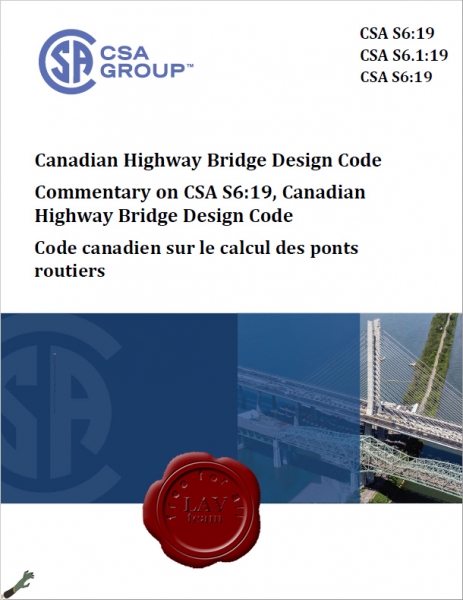
The CSA S6, Canadian Highway Bridge Design Code applies to the design, evaluation and structural rehabilitation design of fixed and movable highway bridges and establishes safety and reliability levels that are consistent across all jurisdictions in Canada. |
| |
 Читать статью дальше (комментариев - 7)
Читать статью дальше (комментариев - 7)
| |
|
 |
 Автор: Williams Автор: Williams
 Дата: 9 ноября 2020 Дата: 9 ноября 2020
 Просмотров: 2 918 Просмотров: 2 918 |
| |
American Concrete Institute:
Building Code Requirements for Structural Concrete (ACI 318-19)
Commentary on Building Code Requirements for Structural Concrete (ACI 318R-19)
SI + IN/LB
ACI, 2019
pdf, 2x628 pages, english
ISBN: 978-1-64195-056-5
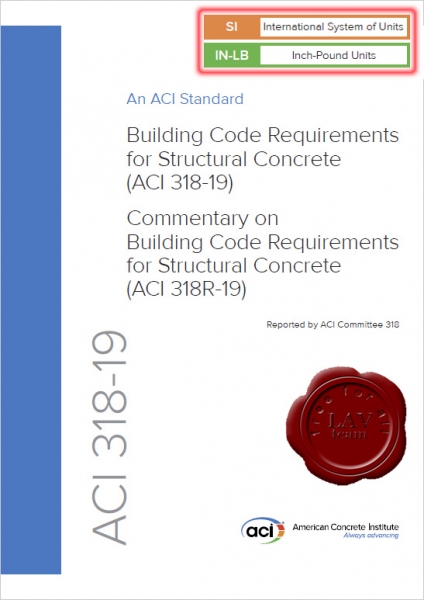
The "Building Code Requirements for Structural Concrete” ("Code”) provides minimum requirements for the materials, design, and detailing of structural concrete buildings and, where applicable, nonbuilding structures. This Code was developed by an ANSI-approved consensus process and addresses structural systems, members, and connections, including cast-in-place, precast, shotcrete, plain, nonprestressed, prestressed, and composite construction. Among the subjects covered are: design and construction for strength, serviceability, and durability; load combinations, load factors, and strength reduction factors; structural analysis methods; deflection limits; mechanical and adhesive anchoring to concrete; development and splicing of reinforcement; construction document information; field inspection and testing; and methods to evaluate the strength of existing structures.
The Code was substantially reorganized and reformatted in 2014, and this Code continues and expands that same organizational philosophy. The principal objectives of the reorganization were to present all design and detailing requirements for structural systems or for individual members in chapters devoted to those individual subjects, and to arrange the chapters in a manner that generally follows the process and chronology of design and construction. Information and procedures that are common to the design of multiple members are located in utility chapters. Additional enhancements implemented in this Code to provide greater clarity and ease of use include the first use of color illustrations and the use of color to help the user navigate the Code and quickly find the information they need. Special thanks to Bentley Systems, Incorporated, for use of their ProConcrete software to produce many of the figures found in the Commentary.
Uses of the Code include adoption by reference in a general building code, and earlier editions have been widely used in this manner. The Code is written in a format that allows such reference without change to its language. Therefore, background details or suggestions for carrying out the requirements or intent of the Code provisions cannot be included within the Code itself. The Commentary is provided for this purpose.
Some considerations of the committee in developing the Code are discussed in the Commentary, with emphasis given to the explanation of new or revised provisions. Much of the research data referenced in preparing the Code is cited for the user desiring to study individual questions in greater detail. Other documents that provide suggestions for carrying out the requirements of the Code are also cited.
Keywords: admixtures; aggregates; anchorage (structural); beam-column frame; beams (supports); caissons; cements; cold weather; columns (supports); combined stress; composite construction (concrete to concrete); compressive strength; concrete; construction documents; construction joints; continuity (structural); contraction joints; cover; curing; deep beams; deep foundations; deflections; drilled piers; earthquake-resistant structures; flexural strength; floors; footings; formwork (construction); hot weather; inspection; isolation joints; joints (junctions); joists; lightweight concretes; load tests (structural); loads (forces); mixture proportioning; modulus of elasticity; moments; piles; placing; plain concrete; precast concrete; prestressed concrete; prestressing steels; quality control; reinforced concrete; reinforcing steels; roofs; serviceability; shear strength; shotcrete; spans; splicing; strength analysis; stresses; structural analysis; structural design; structural integrity; structural walls; T-beams; torsion; walls; water; welded wire reinforcement. |
| |
 Читать статью дальше (комментариев - 13)
Читать статью дальше (комментариев - 13)
| |
|
 |
 Автор: Williams Автор: Williams
 Дата: 7 ноября 2020 Дата: 7 ноября 2020
 Просмотров: 1 620 Просмотров: 1 620 |
| |
American Concrete Institute:
Building Code Requirements for Structural Concrete (ACI 318-19)
Commentary on Building Code Requirements for Structural Concrete (ACI 318R-19)
ACI, 2019
pdf, 628 pages, english
ISBN: 978-1-64195-056-5
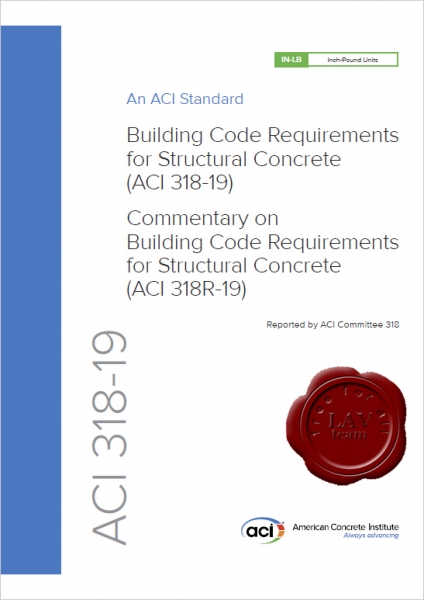
The "Building Code Requirements for Structural Concrete” ("Code”) provides minimum requirements for the materials, design, and detailing of structural concrete buildings and, where applicable, nonbuilding structures. This Code was developed by an ANSI-approved consensus process and addresses structural systems, members, and connections, including cast-in-place, precast, shotcrete, plain, nonprestressed, prestressed, and composite construction. Among the subjects covered are: design and construction for strength, serviceability, and durability; load combinations, load factors, and strength reduction factors; structural analysis methods; deflection limits; mechanical and adhesive anchoring to concrete; development and splicing of reinforcement; construction document information; field inspection and testing; and methods to evaluate the strength of existing structures.
The Code was substantially reorganized and reformatted in 2014, and this Code continues and expands that same organizational philosophy. The principal objectives of the reorganization were to present all design and detailing requirements for structural systems or for individual members in chapters devoted to those individual subjects, and to arrange the chapters in a manner that generally follows the process and chronology of design and construction. Information and procedures that are common to the design of multiple members are located in utility chapters. Additional enhancements implemented in this Code to provide greater clarity and ease of use include the first use of color illustrations and the use of color to help the user navigate the Code and quickly find the information they need. Special thanks to Bentley Systems, Incorporated, for use of their ProConcrete software to produce many of the figures found in the Commentary.
Uses of the Code include adoption by reference in a general building code, and earlier editions have been widely used in this manner. The Code is written in a format that allows such reference without change to its language. Therefore, background details or suggestions for carrying out the requirements or intent of the Code provisions cannot be included within the Code itself. The Commentary is provided for this purpose.
Some considerations of the committee in developing the Code are discussed in the Commentary, with emphasis given to the explanation of new or revised provisions. Much of the research data referenced in preparing the Code is cited for the user desiring to study individual questions in greater detail. Other documents that provide suggestions for carrying out the requirements of the Code are also cited.
Keywords: admixtures; aggregates; anchorage (structural); beam-column frame; beams (supports); caissons; cements; cold weather; columns (supports); combined stress; composite construction (concrete to concrete); compressive strength; concrete; construction documents; construction joints; continuity (structural); contraction joints; cover; curing; deep beams; deep foundations; deflections; drilled piers; earthquake-resistant structures; flexural strength; floors; footings; formwork (construction); hot weather; inspection; isolation joints; joints (junctions); joists; lightweight concretes; load tests (structural); loads (forces); mixture proportioning; modulus of elasticity; moments; piles; placing; plain concrete; precast concrete; prestressed concrete; prestressing steels; quality control; reinforced concrete; reinforcing steels; roofs; serviceability; shear strength; shotcrete; spans; splicing; strength analysis; stresses; structural analysis; structural design; structural integrity; structural walls; T-beams; torsion; walls; water; welded wire reinforcement. |
| |
 Читать статью дальше (комментариев - 18)
Читать статью дальше (комментариев - 18)
| |
|
 |
 Автор: Williams Автор: Williams
 Дата: 5 ноября 2020 Дата: 5 ноября 2020
 Просмотров: 1 385 Просмотров: 1 385 |
| |
Ghazi G. Al-Khateeb - Traffc and Pavement Engineering
CRC, 2021
pdf, 575 pages, english
ISBN-13: 978-0-367-14983-3
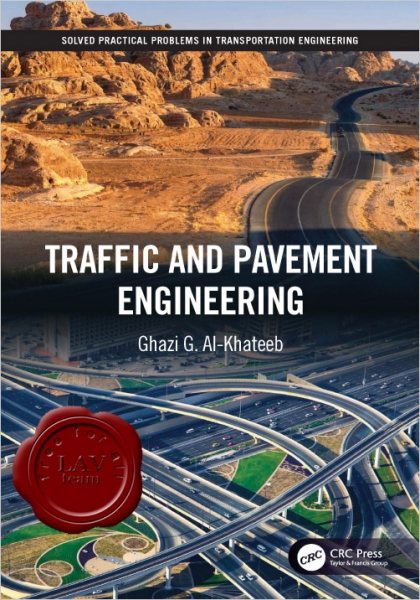
This book, comprising of two volumes and encompassing a total of fve parts, is the outcome of a great deal of effort and time spent over the years in studying and teaching at outstanding academic institutes like Jordan University of Science and Technology, Applied Science University, University of Illinois at Urbana-Champaign, the American University of Sharjah, and the University of Sharjah, and in conducting advanced scientifc research at some of the highly recognized research centers worldwide like the Advanced Transportation Research and Engineering Laboratory (ATREL) at the University of Illinois in Urbana-Champaign, the Federal Highway Administration’s Turner-Fairbank Highway Research Center (TFHRC), advanced research labs at Jordan University of Science and Technology and the Advanced Pavement Research Lab at the University of Sharjah.
The book implements a unique kind of approach and categorizes transportation engineering topics into fve major key areas, as shown below:
- Volume I: Traffc and Pavement Engineering
- Part I ”Traffc Engineering” deals with the functional part of transportation systems and introduces engineering techniques, practices, and models that are applied to design traffc systems, control traffc fow and movement, and construct proper roads and highways to achieve safe and effcient movement of people and traffc on roadways.
- Part II ”Pavement Materials, Analysis, and Design” deals with both the structural and functional parts of transportation facilities and introduces engineering techniques and principles of the uses of high-quality and sustainable materials that are employed to design, maintain, and construct asphalt-surfaced road pavements and concrete rigid pavements. The ultimate goal of pavement engineering is to provide a pavement structure that is safe, durable, sustainable, and capable of carrying the predicted traffc loads under prevailing climatic conditions. Proper structural design of pavements is one that takes into consideration the mechanistic analysis of pavements for stresses and strains that can predict the performance of the pavement with time. This section fulflls this goal by presenting the subject in a unique manner.
- Volume II: Highway Planning, Survey, and Design
- Part I ”Urban Transportation Planning” presents a process that involves a multi-modal approach and comprehensive planning steps and models to design and evaluate a variety of alternatives for transportation systems and facilities, predict travel demand and future needs, and manage the facilities and services for the different modes of transportation to fnally achieve a safe, effcient, and sustainable system for the movement of people and goods.
- Part II ”Highway Survey” presents the basic concepts and standard procedures necessary to make precise and accurate distance, angle, and level measurements for highway alignment, cross-sections, and earth quantities used in the design of highways.
- Part III ”Geometric Design of Highways” deals with engineering design techniques, standards, and models that control the three main elements of highway geometric design: horizontal and vertical alignments, profle, and cross-section to achieve the primary objectives of geometric design: safety, effciency, and sustainability.
|
| |
 Читать статью дальше (комментариев - 6)
Читать статью дальше (комментариев - 6)
| |
|
 |
 Автор: Williams Автор: Williams
 Дата: 3 ноября 2020 Дата: 3 ноября 2020
 Просмотров: 7 547 Просмотров: 7 547 |
| |
Udemy (Cezary Wozniak) - Advanced UAV Photogrammetry - Part 2 - Pix4D Mapper - 2019
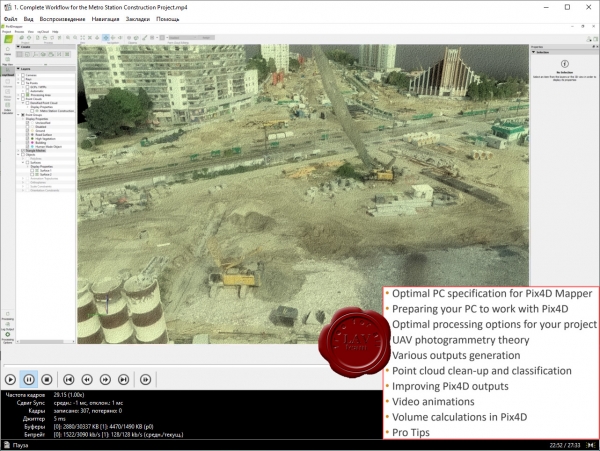
Master UAV Photogrammetry data processing in Pix4D Mapper with the most complete course on the market!
Achieve the most accurate results with UAV Photogrammetry on real-world examples.
This course covers:
- Creating a new project.
- Choosing optimal processing options.
- Accurate georeferencing using GCPs.
- GCP marking.
- Ellipsoid error correction.
- Quality assessment.
- Project splitting and merging.
- Tips and tricks.
- and more!
|
| |
 Читать статью дальше (комментариев - 23)
Читать статью дальше (комментариев - 23)
| |
|
 |
 Автор: Williams Автор: Williams
 Дата: 1 ноября 2020 Дата: 1 ноября 2020
 Просмотров: 1 930 Просмотров: 1 930 |
| |
Nandipati Subba Rao - Hydrogeology problems with solutions
PHI Learning Private Limited, 2016
pdf, 336 pages, english
ISBN: 978-81-203-5278-0

Numerical calculations are inevitably required in the field of hydrogeology and play a significant role in dealing with its various aspects. As often as not, students are seen struggling while solving numerical problems based on hydrogeology, as they find difficulty in identifying the correct concept behind the problem and the formula that can be applied to it. Also, there is a dearth of books, which help the readers in solving numerical problems of varied difficulty level and enable them to have a firm grounding in the subject of hydrogeology. The book Hydrogeology: Problems with Solutions fills this void in the finest way, and as desired, chiefly focuses on the sequential steps involved in solving the problems based on hydrogeology. It concisely covers the fundamental concepts, advanced principles and applications of hydrogeological tasks rather than overemphasising the theoretical aspects.
The text comprises sixty solved hydrogeological problems, which are logically organised into ten chapters, including hydrological cycle, morphometric analysis, hydrological properties, groundwater flow, well hydraulics, well design and construction, groundwater management, seawater intrusion, groundwater exploration and groundwater quality. The practice of pedagogy of hydrogeology in yesteryears was a two-tier approach of theoretical principles with toy problems and in-situ case studies for research start-up. This book bridges the gap between routine problem-solving and state-of-the-practice for future.
The book is primarily intended for the undergraduate and postgraduate students of Earth Sciences, Civil Engineering, Water Resources Engineering, Hydrogeology and Hydrology. It also serves as an excellent handy reference for all professionals. |
| |
 Читать статью дальше (комментариев - 12)
Читать статью дальше (комментариев - 12)
| |
|
 |
 Автор: Williams Автор: Williams
 Дата: 30 октября 2020 Дата: 30 октября 2020
 Просмотров: 2 955 Просмотров: 2 955 |
| |
Christopher Gorse, David Johnston, Martin Pritchard - Oxford Dictionary of Construction, Surveying and Civil Engineering
Oxford University Press, 2020
epub, 624 pages, english
ISBN-13: 978-0-198-83248-5
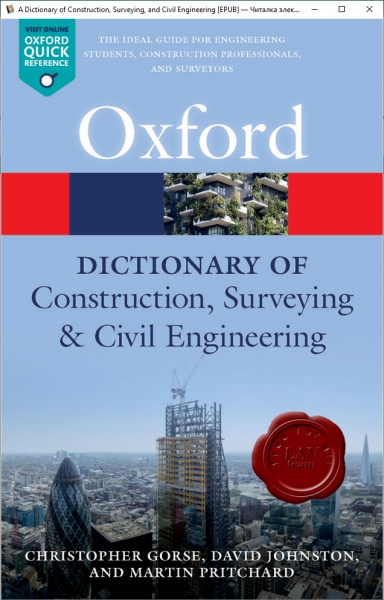
This new edition of A Dictionary of Construction, Surveying, and Civil Engineering is the most up-to-date dictionary of its kind. In more than 8,000 entries it covers the key areas of civil and construction engineering, construction technology and practice, construction management techniques and processes, as well as legal aspects such as contracts and procurement.
It has been updated with more than 600 new entries spanning subjects such as sustainability, new technologies, disaster management, and building software. New additions include terms such as Air source heat pump, hydraulic failure, mechanical ventilation with heat recovery, off-site construction, predictive performance, sustainable development, and value engineering. Useful diagrams and web links complement the text, which also includes suggestions for further reading.
With contributions from more than 130 experts from around the world, this dictionary is an authoritative resource for engineering students, construction professionals, and surveyors. |
| |
 Читать статью дальше (комментариев - 19)
Читать статью дальше (комментариев - 19)
| |
|
 |
 Автор: Williams Автор: Williams
 Дата: 28 октября 2020 Дата: 28 октября 2020
 Просмотров: 941 Просмотров: 941 |
| |
Achim Schmidt - Technical Thermodynamics for Engineers, Basics and Applications
Springer, 2019
pdf, 831 pages, english
ISBN: 978-3-030-20396-2

Thermodynamics is a subject that all engineering students have to face and that most of them treat with great respect. This makes it all the more important to offer a good and easy-to-understand approach to the laws of energy conversion. This is what this textbook is intended to do: It covers the basics of classical technical thermodynamics as they are typically taught at universities: The first and second law of thermodynamics as well as equations of state are explained for idealized and real fluids which are subject to a phase change. Thermodynamic mixtures, e.g. humid air, are treated as well as chemical reactions. Components and thermodynamic cycle that convert energy are presented. The book attaches great importance to drawings and illustrations, which should make it easier to comprehend complex matter. Technical applications and apparatus are presented and explained. Numerous exercises and examples conclude the book and contribute to a better understanding of the theory. |
| |
 Читать статью дальше (комментариев - 6)
Читать статью дальше (комментариев - 6)
| |
|
 |
 Автор: Williams Автор: Williams
 Дата: 26 октября 2020 Дата: 26 октября 2020
 Просмотров: 1 815 Просмотров: 1 815 |
| |
Athanassios Nikolaides - Highway Engineering
Pavements, Materials and Control of Quality
CRC, 2015
pdf, 868 pages, english
ISBN-13: 978-1-4665-7997-2
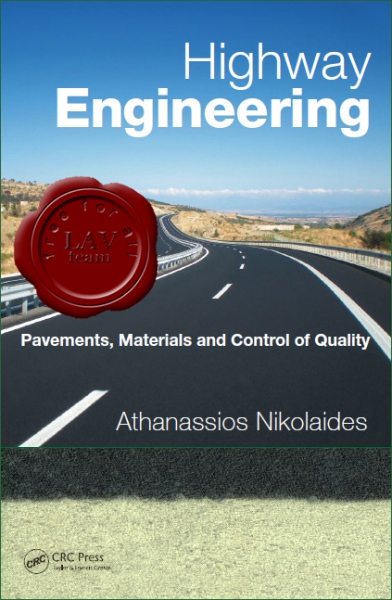
Highway engineering is the term that replaced the traditional term road engineering used in the past, after the introduction of modern highways. Highway engineering is a vast subject that involves planning, design, construction, maintenance and management of roads, bridges and tunnels for the safe and effective transportation of people and goods.
This book concentrates on design, construction, maintenance and management of pavements for roads/highways. It also includes pavement materials since they are an integral part of pavements. It has been written for graduates, postgraduates as well as practicing engineers and laboratory staff and incorporates the author’s 30 years of involvement in teaching, researching and practicing the subject of highway engineering.
Advancements in pavement materials, design, construction, maintenance and pavement management and the globalisation of the market make it imperative for the highway engineer to be aware of the techniques and standards applied globally.
One of the objectives of the book is to provide integrated information on the abovementioned disciplines of highway engineering.
Another objective is to include in one book both European and American standards and practices (CEN EN, ASTM, AASHTO and Asphalt Institute). This would result in a more useful reference textbook to pavement engineering courses taught in European and American educational establishments.
Another objective of this book is to provide a reference textbook to practicing pavement engineers and materials testing laboratory staff, working in countries employing European or American standards and techniques.
Apart from information regarding European and American practices, the reader can also find some specific information on practices employed in countries such as the United Kingdom, France and Greece, as well as Australia.
In addition, this book also aims to provide integrated information related to pavement materials (soil, aggregates, bitumen, asphalts and reclaimed material), material testing for acceptability and quality assurance, asphalt mix design, flexible and rigid pavement design, construction, maintenance and strengthening procedures, quality control of production and acceptance of asphalts, pavement evaluation, asphalt plants and pavement recycling. It also covers the basic principles of pavement management.
The book in its 18 chapters contains many tables, graphs, charts and photographs to assist the reader in learning and understanding the subject of pavement engineering and materials. It also contains a great number of references, a valuable tool to help the reader seek more information and enhance his or her knowledge.
The short description of all pavement material testing procedures, required by Europeanand American standards, as well as pavement design and maintenance procedures covered, does not, by any means, substitute or replace the standards and procedures developed by the various organisations and agencies. The reader is advised to always consult the standards or manuals developed when engaged in testing, design, construction or maintenance works.
It is hoped that this textbook will not only contribute to the understanding of the wide and challenging subject of pavement engineering but also enable a more effective and economical design, construction and maintenance of pavements by employing updated standards, practices and techniques. |
| |
 Читать статью дальше (комментариев - 10)
Читать статью дальше (комментариев - 10)
| |
|
 |
 Автор: Williams Автор: Williams
 Дата: 24 октября 2020 Дата: 24 октября 2020
 Просмотров: 2 102 Просмотров: 2 102 |
| |
M. Rashad Islam, Rafiqul A. Tarefder - Pavement Design
Materials, Analysis, and Highways
McGraw Hill, 2020
pdf, 574 pages, english
ISBN: 978-1-26-045892-3
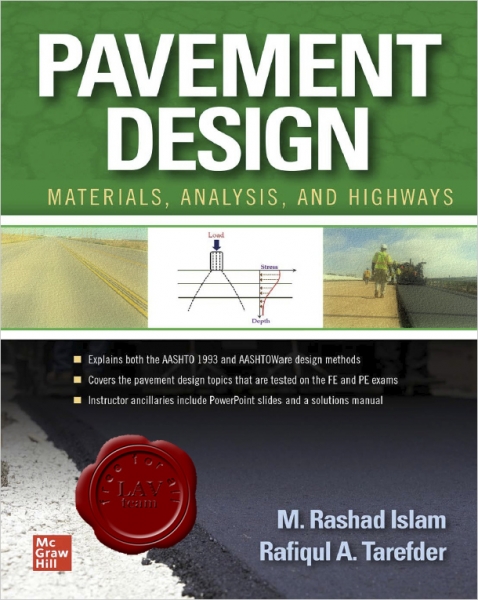
The authors are delighted to introduce this pavement design book to civil engineering students. It focuses on the most recent invention in pavement design, the pavement mechanistic-empirical (ME) design approach. Practical design examples are included in this textbook to help students understand the pavement mechanics and models used in this new approach. Fundamentals of Engineering (FE) exam-style questions are also included so that this book can be helpful for the FE examination as well. The authors believe that this text will be valuable for understanding pavement engineering. |
| |
 Читать статью дальше (комментариев - 19)
Читать статью дальше (комментариев - 19)
| |
|
 |
| ПОИСК ПО САЙТУ |
 |
|
 |
|